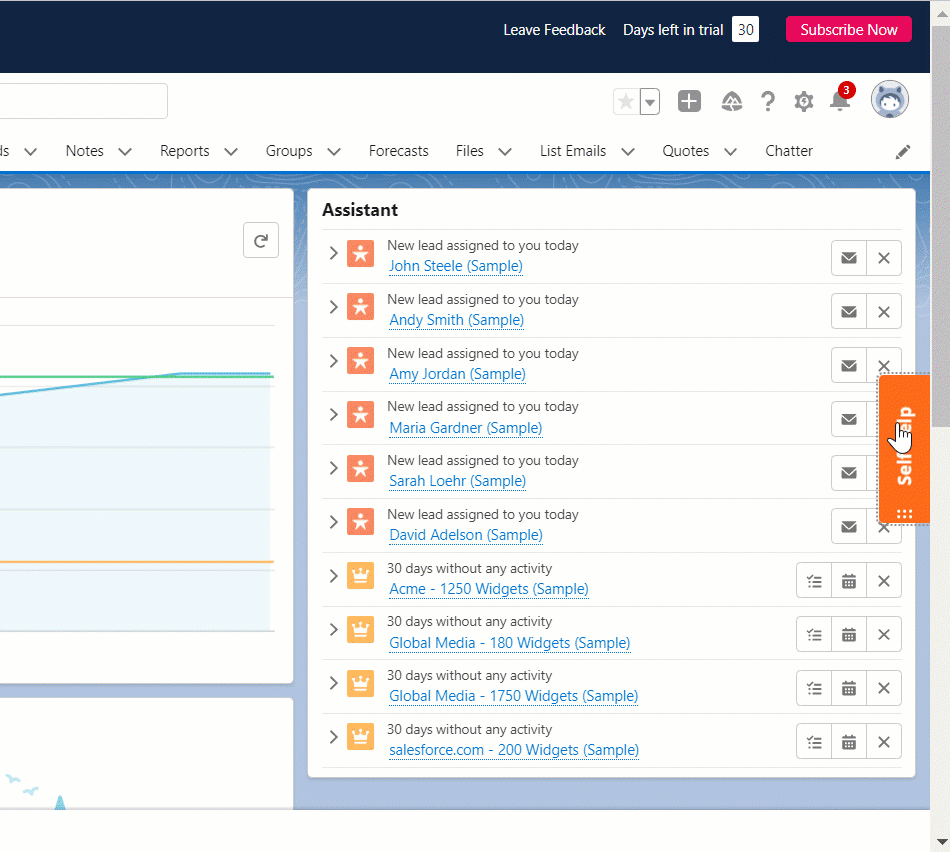
Field Service Support: How to Enable Your Technicians
- Published:
- Updated: May 14, 2024

Field service employees are the frontline ambassadors of service-based businesses, fulfilling customers’ needs and keeping business operations flowing.
Field service management employees often work independently and not in traditional offices, so they rely on high-quality support from field service managers to optimize schedules, manage support tickets, and perform efficiently.
In this article, we’ll explore the benefits of supporting your field service employees, challenges you might face along the way, and how a DAP can empower them on the job.
What Is Field Service Support?
Field service support refers to the resources, training, and assistance provided by an organization to its field service workers.
Field service support can entail formalized efforts like training programs and the implementation of field service management (FSM) software. It also includes critical aspects of employee support like clear communication, proper safety protocols, peer support networks, and opportunities for feedback and growth.
Ultimately, providing exceptional support to field service team members is critical for increasing productivity, improving job satisfaction, and boosting the quality of your company’s service offerings.
Benefits of Supporting Field Service Employees
Organizations can support field service workers and enhance work experience through comprehensive field service support implementation. Here are some of the most prevalent benefits of providing support to field service employees:
1. Enhances customer satisfaction and loyalty
Employees who feel supported by their managers and generally cared for at work are more engaged in their everyday tasks and are more inclined to go above and beyond to resolve issues and leave customers satisfied. Well-supported field service workers tend to be more engaged and resolve issues more quickly. This leads to higher customer satisfaction and repeat business, establishing a foundation for a strong customer-brand relationship moving forward.
2. Boosts employee morale and retention
When employees receive the support, training, and resources they need, they have a more positive overall experience at work, participate in workplace culture, and put more energy into professional growth and upward mobility.
The best part about this is that as long as employees feel supported, they’ll likely choose to grow with their organizations rather than seek opportunities elsewhere. This way, proper field service employee support is a strong defense against rising employee turnover.
3. Increases operational efficiency and productivity
Field service employees rely on their employers to provide the tools and information they need to complete everyday tasks and for additional support when issues escalate. Through field service management, which can be bolstered by FSM software, management teams can optimize field service processes and protocols, provide moment-of-need support, and empower field service employees to complete tasks more quickly and accurately.
4. Ensures safety and compliance
Field service team members often work with potentially dangerous tools, visit customer residences, and handle sensitive personal information. This makes adhering to safety protocols and industry regulations an essential aspect of field service.
With proper field service support, management teams can provide optimized workflows and training to reduce risks of accidents and injuries and protect customers, workers, and your larger organization.
5. Improves brand reputation and trust
The quality of a business’ field service directly impacts how its brand is perceived by the public. Through field service support, field service workers are empowered to provide efficient, reliable service, which leads to more positive interactions with customers and a constantly improving brand reputation.
6. Facilitates problem-solving and innovation
Well-supported employees are more likely to feel comfortable collaborating with others to solve problems and provide sincere feedback and suggestions for process improvement. Create an open, supportive environment for your field service personnel to promote creativity and facilitate innovation in the workplace.
7. Enhances decision-making
Field service support empowers field service support personnel with the training and information they need to feel confident in their decisions. Modern field service management solutions provide field service workers with real-time data analytics and insights to help personnel make informed decisions on the spot, improving service outcomes and customer satisfaction.
8. Reduces costs
Well-supported field service employees work more efficiently, which can substantially impact operational costs. From travel to time and other vital resources, field service employee support can help field service teams cut costs and contribute to better financial performance.
9. Improves employee skill set and knowledge
Continuous training and support for field service employees not only have immediate positive impacts on their current performance, but also prepare them for future challenges and opportunities. This strong foundation and sense of continual improvement ensures that employees continue to grow and that the business can stay competitive in evolving industries.
10. Adapts to technological advancements
Supporting field service employees with the latest tools and training keeps your team on the cutting edge. With proper training and plenty of growth opportunities, field service employees can learn and leverage new technologies as they emerge.
11. Expands market competitiveness
Organizations that prioritize field service management and support provide high-quality service to customers. This improves brand reputation and sets your organization apart from competitors, which can be the deciding factor when customers are choosing between providers.
12. Enables scalability
Organizations with optimized field support systems and infrastructure are well-equipped to scale field service operations as they grow. By supporting field service employees as their teams evolve, managers can ensure continued productivity without sacrificing quality or efficiency.

Common Challenges Faced by Field Service Employees
The dynamic nature of field service work brings a variety of challenges for field service employees, which can have detrimental effects on any business. Thankfully, these challenges can be monitored and alleviated by implementing strong field service management and support.
Here are some of the most common challenges field service employees face today:
1. Difficulty accessing real-time data and customer history in remote locations
When field service workers arrive at a job, they need access to customer history and real-time data to gather all the context they need to resolve an issue. This can be especially problematic when field locations are remote or without Wi-Fi. Provide employees with modern field service management technology to ensure consistent access to important records and other resources.
2. Maintaining effective communication with the central office and customers
Similarly, the mobile nature of field service work can present communication issues, especially in more remote areas. Field service workers need high-quality communication tools to ensure that field service employees can reach customers and contact the central office for supplemental support as needed.
3. Resistance or difficulty in adopting new digital tools and technologies
Change is often uncomfortable, and in the age of digital transformation, changes can come quickly and constantly. To alleviate this resistance to change, field service managers should provide continuous training and clear communication while remaining transparent about why impending changes are necessary and beneficial.
4. Ensuring personal safety while working in varying and potentially hazardous environments
Field service employees need to feel supported and safe on the job, as they may be required to enter potentially dangerous environments. Field service managers need to provide their team members with the most up-to-date safety protocol and effective communication channels to ensure they feel safe and cared for when they go to work every day.
5. Balancing urgent service calls with routine maintenance and administrative tasks
When service requests in different locations are constantly pouring in, it can be difficult to prioritize site visits based on urgency and location. Eliminate this stress with field service management software that uses AI and automation to produce optimized dispatch schedules and routes based on all work orders.
6. Keeping up with the technical skills required for increasingly complex service demands
Field service technicians work with rapidly evolving equipment and technology, and are expected to adapt just as quickly to serve customers. This constant need for retraining and upskilling presents challenges that can be remedied by supporting teams with modern learning software that provides personnel with continuous training via microlearning lessons and in-app messaging.
7. Managing and meeting rising customer expectations for rapid and effective service
Customers expect speedy and efficient service, even when it comes to the most complex technical issues. They may have stayed home from work to allow access to field service technicians and want to be able to get back to their regular schedules. These expectations can be difficult to meet, but field service managers can support their teams with easily accessible training and troubleshooting resources to improve resolution times and keep customers satisfied.
8. Limited access to support and guidance when facing complex issues in the field
When it comes to complex issues, field service employees need to tap into troubleshooting guidance and manager support. In these situations, phone calls won’t cut it— managers should equip employees with modern IoT devices that allow them to access real-time guidance to avoid extended downtime or scheduling follow-up visits.
9 Ways to Support Your Field Service Workers
While field service needs and challenges vary across industries, certain best practices consistently benefit managers seeking to support their field service teams. Follow these strategies to develop a plan for supporting your organization’s field service team:
1. Conduct surveys and interviews to identify specific needs and challenges
Take regular opportunities to conduct surveys and interviews with field service workers. Solicit honest feedback and use that information to improve processes while staying in communication with teams about changes throughout implementation.
Whatfix Surveys provides a comprehensive solution that allows you to seamlessly gather feedback from your field service teams, ensuring their voices are heard and their concerns addressed effectively. The intuitive survey platform allows you to create customized surveys tailored to your organization’s unique requirements, making it easy to collect honest feedback on processes, tools, and challenges faced on the ground. The analytics dashboard also provides valuable insights, empowering you to make data-driven decisions to enhance your field service operations.
2. Invest in digital tools that provide in-app guidance and moment of need support for your field service technicians
Managers aren’t magicians; they also need adequate resources to support their teams best. Use tools like field service management software to automate administrative processes, provide contextual moment-of-need support, and lighten workloads and stress levels.
With a digital adoption platform like Whatfix, create in-app guided experiences overlaying your tablet and mobile field service management applications that provide contextual support to your technicians.
With Whatfix, create in-app training and onboarding experiences like Tours, Flows, and Task Lists to help get technicians up to speed fast. Use in-app Pop-Ups to make announcements to your technicians no matter where they are.

Use Self Help to provide an on-demand resource center to your employees. It integrates with your SOPs, process documents, training resources, and more – providing a searchable help center when technicians encounter issues or need support in the field.

3. Create role-based training programs tailored to the skills and tools required for field service work
Using digital learning management systems and digital adoption platforms allows you to develop custom-tailored training to meet field service workers’ needs. You can make lessons concise and engaging, and provide regular opportunities for personnel to brush up on skills and learn about process updates as they roll out.
Whatfix’s digital learning management system (LMS) and digital adoption platform (DAP) enable you to develop engaging and personalized training content that caters specifically to the skills and tools required for field service work. With Whatfix, you can deliver interactive training modules that are easily accessible to your field service personnel, ensuring they have the knowledge and skills they need to excel in their roles. Whether it’s onboarding new hires or upskilling existing employees, Whatfix makes it simple to deliver effective training programs that drive results.
4. Implement systems for efficient communication between field employees, management, and customers
Field service workers navigate complex systems while performing their duties and relaying progress to customers and managers. Support field service workers by utilizing communication and field service management software that enables real-time reporting to keep progress transparent across the board without requiring additional work.
5. Encourage a culture of support, feedback, and continuous improvement
Field service support is not a one-time activity; it requires a widespread culture of continuous support and improvement. Leadership should demonstrate their stakes in employee success by encouraging feedback, making necessary changes, and providing regular opportunities for training and growth.
With Whatfix, you can create feedback channels where field service workers can share their thoughts, ideas, and suggestions for improvement. The robust analytics capabilities allow you to track feedback trends over time, helping you identify areas for enhancement and measure the impact of your improvement efforts. By fostering a culture of open communication and continuous feedback with Whatfix, you can empower your field service teams to thrive and excel in their roles.
6. Ensure easy access to necessary information, manuals, and customer history
When field service workers arrive at a job, they need to get up to speed quickly, which can be challenging without modern field service management tools. Managers can eliminate frustration and ensure that field representatives can work efficiently by providing instant access to customer history and knowledge databases.
7. Develop and enforce safety protocols tailored to different field environments
Safety and compliance should always be a priority. Managers must ensure that team members know how to handle issues and service assets from any location safely. This requires not only comprehensive safety training, but also 24/7 access to relevant support and resources.
8. Provide opportunities for upskilling and professional development
Without adequate support, field service workers can feel disconnected from your larger organization and feel like they’re missing out on growth opportunities. To alleviate this, managers should maintain consistent communication with their team members and provide regular opportunities for progress reviews and professional development opportunities. This not only builds a sense of trust and engagement, but can help propel field service workers forward in their careers with your organization.
9. Regularly review the effectiveness of support strategies and make adjustments as needed
It’s important for field service managers to consistently evaluate and adjust their support efforts to ensure that employees feel well-supported and confident in their roles. By regularly checking in with employees and gathering feedback, managers can identify areas for improvement and make necessary changes to policies, procedures, and training programs. This can help to foster a positive and productive work environment, boost employee morale and satisfaction, and ultimately improve the quality of service provided to customers. By prioritizing employee support and making it an ongoing and iterative process, field service managers can ensure that their workforce feels heard, valued, and well-equipped to succeed in their roles.
How DAPs Enable Field Service Technicians With Real-Time Support
Now more than ever, field service technicians rely on supplemental technology and devices to assist in asset maintenance and equipment repairs. With software playing such a prominent role in field service operations, digital adoption platforms can be integrated with field service applications to streamline operations and improve performance and efficiency.
1. Flows to support digital process governance
Digital adoption platforms provide field service technicians with guided experiences that ensure they follow the optimal process steps and user journeys. This empowers IT teams to build process governance and that technicians follow the correct paths.
2. Self Help for overcoming common field challenges, troubleshooting issues, and finding support resources
Most DAPs include knowledge bases that can be populated with helpful information and how-to guides. This makes providing 24/7 support for field service workers easy and frees managers’ time to help with more complex issues.
With Whatfix Self Help, integrate your knowledge base, help desk, SOPs, process documents, and more into one searchable knowledge base that overlays your FSM software and enables your technicians at any time in the flow of work.
3. Field Validation to ensure correct data is collected in the right format
Field validation is an automated process that ensures information is entered into forms correctly before it’s accepted. This helps ensure field service teams are consistently collecting organized, accurate records. With the amount of documentation involved in field service compliance and quality assurance, digital adoption platforms with built-in field validation can help improve data collection processes and prevent issues down the line.
4. Smart Tips to provide field workers additional knowledge at key moments
Digital adoption platforms include in-app messaging to guide field service employees through challenges when they need support. Smart tips can be set to appear as messages or icons when employees take specific actions within an application. Get them what they need more quickly. This tool helps field service employees navigate software without navigating away for support resources or seeking assistance when they hit a simple roadblock.

To effectively support your field service employees, it’s crucial to provide them with the right tools and guidance. A seamless digital experience ensures that they can efficiently utilize field service management software in any situation, from routine maintenance to complex repairs. By empowering employees with contextual guidance, proactive assistance, and detailed analytics, businesses can enhance productivity, reduce errors, and foster a more capable and confident workforce. This foundation enables teams to focus on delivering exceptional service while adapting to evolving challenges.
Partnering with Whatfix can transform how your organization supports its field service workforce. The digital adoption platform revolutionizes the way your teams interact with their field service management software. By leveraging in-app messaging and robust data analytics, Whatfix delivers contextual guidance directly within the applications your employees use daily. This approach not only simplifies the user experience, but also helps employees maximize their efficiency and effectiveness by providing real-time, step-by-step guidance tailored to their needs.
Discover how Whatfix can elevate your support for field service employees and drive your business success.

Thank you for subscribing!



